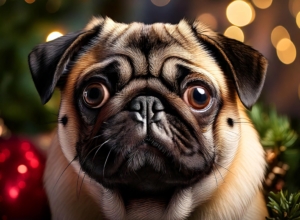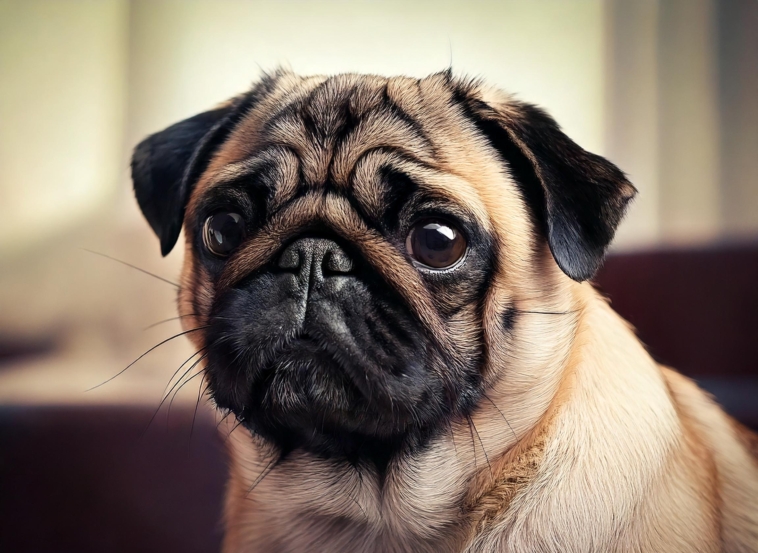Welcome to the World of Pug Problems (and How to Survive It)
Pugs are living, breathing stuffed animals—soft, cuddly, and loving. But there’s another side to pugs, one that’s hidden behind those cute bulging peepers. That smaller four-legged gremlin with attitude is just going on the occasional ride within your pug baby. Panic not—don’t worry, it’s not you, it’s probably. also a tad bit you. But most of all, it’s pug personality.
Here are some typical “Why is my pug so dramatic like a toddler?” issues:
- Separation Anxiety: You leave the room? Boom—havoc. Your pug is a soap opera when you’re not around.
- Aggression: More “back off, it’s my sock” than Cujo.
- Housebreaking Headaches: Potty training a pug is possible, but like trying to teach a cat to dance—it’s draining.
- Excessive Barking: Pugs are half dog, half foghorn.
- Resource Guarding: Yes, that sloppy toy is now Excalibur. Touch it, and they’ll defend it like a knight in combat.
Understanding these quirks is your first step toward not losing your mind.
Pug Traits: A Cocktail of Sass, Snuggles & Stubborn
Before you accuse your pug of chewing the TV remote once again, let’s get to know what makes them tick:
- Affectionate: Your pug will tag along to the bathroom with you. Every. Single. Time.
- Playful: Throw a sock, and you’ve just set 10 minutes of Olympic-grade fetch (with no rules) in motion.
- Adaptable: House? Apartment? Castle? They’ll do just fine anywhere there are snacks.
- Stubborn: Pugs don’t take orders—they view them as suggestions.
- Sociable: Loves everyone—until someone comes between them and their beloved blanket.
- Vocal: Your pug has a full-time job as a barker. And they’re putting in overtime.
Why Do Pugs Misbehave? Spoiler: It’s Not Just to Annoy You
Behavioral issues aren’t born of a need to destroy your couch. (Well, not entirely.) Here’s what’s happening behind those puppy eyes:
- Lousy Socialization: Didn’t get enough sniff-and-greet time as a puppy? Now every dog is a threat.
- No Exercise = Anarchy: A bored pug is a wrecking pug. Consider mini wrecking ball with wrinkles.
- Medical Issues: Sudden crankiness? Could be something medical—those little bodies can be fragile.
- Genetic Drama: Some pugs are just born nervous. Like little fretful actors in a dog telenovela.
- Training? What Training?: Mixed signals = dazed pug = pandemonium. Consistency is your best buddy (after your pug, naturally).
Barking 101: Why Pugs Yell at Nothing (and How to Get Them to Chill)
Pugs are chatty. They just don’t speak English, so opinions are rendered in bark. Here’s why your pug is yelling at thin air:
- Boredom: No fun? SNAPO!
- Lonely & Needy: Classic pug. They bark because they already miss you—even if you’re 4 feet away.
- Attention-Seeking: “Look at me!” bark “Still not looking?” BARK BARK BARK
- Guard Duty Activated: A leaf shifted? INTRUDER ALERT!
- Ouchies: Anyone can get cranky with pain, particularly your soft little pug.
What You Can Do:
- Take them for walks—but not a pug marathon. More like a courtesy stroll.
- Train commands such as “quiet,” “no,” and “I love you but please be quiet.”
- Provide toys. The squeakier, the better.
- Vet check if the barking is new or accompanied by other quirkiness
Handling Pug Aggression (Yes, It Happens. Sometimes.)
Pug aggression is like watching your grandmother attempt to perform karate. It’s unusual and perplexing, but it occurs:
- Fear-Mediated: Noises? Strangers? Panic station engaged.
- Possessive Instincts: That partially chewed toy is now theirs alone.
- Anti-Social Butterfly: Lousy socialization can make playdates become showdowns.
How to Fix It (Without Enrolling Them in Anger Management):
- Discover the why of the growl.
- Apply positive reinforcement (bribes are magic).
- Call in the professionals—vets or dog trainers, not Dr. Phil.
- Establish a regular routine so your pug isn’t hangry and confused.
Separation Anxiety: Your Pug, The Clingy Roommate
Pugs possess two moods: “you’re here” and “WHY DID YOU LEAVE ME?” If your pug freaks out whenever you leave, you may be facing separation anxiety.
Red flags are:
- Yapping or whining as if performing for Broadway.
- Trashing everything except their toys.
- Pacing like a hyperactive intern.
- Jailbreak attempts.
How to Save Your Sanity:
- Practice “mini goodbyes” (don’t ask, just do it).
- Offer interactive toys (Kongs > couches).
- Follow a schedule.
- Establish a quiet zen room for quiet time.
- Still not working? Time to call a dog whisperer.

Potty Training: Or, How to Get a Stubborn Pug to Pee Outside
Pugs + house training = drama. They’re intelligent, sure—but also lazy and easily distracted. So essentially, pug training is like attempting to get a toddler to use the toilet at the carnival.
Shared Challenges:
- Inconsistency: Miss a day, and your pug forgets everything.
- Oopsies: It’s going to happen. Stock up on paper towels.
- Tiny Bladders: More pit stops than a road trip.
- Squirrel!: Training session over.
How to Deal:
- Stick to routine. Even if they act like they’ve never heard of the word “potty.”
- Reward like they cured cancer every single time they go outside.
- Crate train gradually—delicate little spuds.
- Professional trainer? Costly, but sometimes the only thing that will ensure your carpets survive.
Chew On This: Pug-Proofing Your Life
Got teeth marks on your TV remote? Welcome to pug ownership! But destructive chewing can be managed—before your furniture pays the price.
Tips to Tame the Chewing Beast:
- Give them toys harder than your temper.
- Keep ’em in motion—boredom = mayhem.
- Instruct “drop it” and “cease chewing my beloved shoes.”
- Puppy-proof your abode like they’re a small, fluffy whirlwind.
Social Life for Pugs: Because They’re Basically Furry Extroverts
Socializing your pug means fewer awkward growls and more tail wags at the dog park.
Strategies for Success:
- Get a head start: Introduce them to humans, dogs, and that annoying vacuum.
- Plan playdates. Doggy BFFs = less attitude.
- Obedience classes: Perfect for training, plus socialization.
- Routines = comfort. Don’t spring “new people day” on them.
- Interactive toys = built-in buddy (who won’t steal all the treats).
Training Like a Pro (Or at Least Like You Know What You’re Doing)
Pugs are trainable—you just have to be stern and bribe-laden. Treat it as training a toddler with a bad attitude and an insatiable appetite for cheese.
Top Methods:
- Positive Reinforcement: Praise, treats, squeaky toys—all that works.
- Consistency: Use the same words, routine, and zeal.
- Obedience Training: Begin with sit, stay, and don’t nibble grandma’s slippers.
- Crate Training: Turn the crate into a spa, not a jail.
- Socialization: Confidence increases with new experiences (and belly rubs).
When to Call in Reinforcements (a.k.a. Professionals)
There’s no need to be ashamed of calling in the doggy cavalry. If your pug begins to behave like a furry gremlin and nothing is working, it’s time to call in the professionals.
Symptoms that you need assistance:
- Escalating aggression.
- Panic-level anxiety.
- Compulsive behavior (tail chasing, wall licking, etc.).
- Selective hearing during training. (Not when there are snacks involved, though.)
A veterinarian or trainer can provide custom plans that will bring both you and your pug more joy.
Final Snorts: A Well-Behaved Pug is a Loved Pug
The key to a content, non-chaotic pug existence? Knowing their quirks, embracing their goofiness, and outwitting their stubbornness. Remember:
- Utilize the same training techniques (it’s surprisingly easy to confuse a pug).
- Build confidence through socialization and plenty of praise.
- Treat them like royalty—but also like the pesky little goblins they are.
- Above all: Keep them happy, healthy, and perhaps a tad spoiled.
Because at the end of the day, behind that wheezy bark and permanent “help me” face is a loyal little furball who just wants to love and be loved (preferably sitting on your lap).




